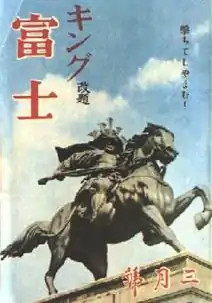Kingu (magazine)
Kingu (キング, from English King) was a Japanese monthly general interest and entertainment magazine published in Tokyo, Japan. The magazine existed between December 1924 and January 1957. It was the first popular best-selling Japanese magazine.[1] It was also one of two most significant magazines in mid-twentieth century Japan, the other one being Ie no Hikari.[2]
 1943 edition of the magazine | |
| Categories | General interest |
|---|---|
| Frequency | Monthly |
| Founder | Seiji Noma |
| Year founded | December 1924 |
| First issue | January 1925 |
| Final issue | 1957 |
| Company | Kodansha |
| Country | Japan |
| Based in | Tokyo |
| Language | Japanese |
| OCLC | 835840343 |
History and profile
Kingu was established in December 1924.[3] The first issue appeared in January 1925.[4][5] It was the eighth magazine launched by Seiji Noma (1878-1938), the founder of the publishing company Kodansha.[6][7] It was modeled on Saturday Evening Post.[8] The magazine was published by Kodansha[9] on a monthly basis.[6][7]
Kingu covered moralistic stories[6] and featured articles about samurai heroics, sentimental romance and melodramatic events.[10] The magazine was read by urban and rural men and women.[4] Major contributors included Yoshikawa Eiji, Kikuchi Kan, Maki Itsuma, Funabashi Seiichi, Tateno Nobuyuki, and Tsunoda Kikuo.[5] It ended publication in 1957.[4]
Circulation
Both Kingu and Ie no Hikari were the first Japanese million-seller magazines.[11] Kingu sold one million copies in its first year, 1925.[4] In 1928 the monthly circulation of the magazine was nearly 300,000 copies.[12] The same year its total circulation was 1.4 million copies.[13]
Legacy
In 2019 Amy Bliss Marshall published a book named Magazines and the Making of Mass Culture in Japan in which she analysed Kingu and Ie no Hikari to demonstrate the birth of mass culture in Japan.[14] The author argues that these two magazines were instrumental in the establishment of mass culture and in the socialization in Japan.[14]
References
- Barbara Sato (16 April 2003). The New Japanese Woman: Modernity, Media, and Women in Interwar Japan. Duke University Press. p. 190. ISBN 0-8223-3044-X.
- "Mass Culture in Interwar Japan". Dissertation Reviews. 11 February 2013. Retrieved 17 September 2016.
- Kazumi Ishii (August 2005). "Josei: A Magazine for the 'New Woman'". Intersections: Gender, History and Culture in the Asian Context (11).
- Gender and Modernity in Colonial Korea. ProQuest. 2005. p. 53. ISBN 978-0-549-71329-6.
- "A Guide to Japanese References and Research Materials". University of Michigan. Retrieved 17 September 2016.
- "History of Kodansha Ltd". Funding Universe. Retrieved 17 September 2016.
- Richard J. Jensen (1987). In Search of Justice: The Indiana Tradition in Speech Communication. Rodopi. p. 38. ISBN 90-6203-968-5.
- "Timeline of Modern Japan (1868-1945)". About Japan. Retrieved 17 September 2016.
- Louise Young (1999). Japan's Total Empire: Manchuria and the Culture of Wartime Imperialism. University of California Press. p. 72. ISBN 978-0-520-21934-2.
- Mary L. Hanneman (14 November 2013). Japan faces the World, 1925-1952. Taylor & Francis. p. 29. ISBN 978-1-317-87895-7.
- Amy Bliss Marshall (October 2013). "Devouring Japan: Proposal" (PDF). University of Texas. Archived from the original (PDF) on 9 August 2016. Retrieved 17 September 2016.
- Elise K. Tipton; John Clark (2000). Being Modern in Japan: Culture and Society from the 1910s to the 1930s. University of Hawaii Press. p. 35. ISBN 978-0-8248-2360-3.
- Sandra Wilson (Summer 2011). "Enthroning Hirohito: Culture and Nation in 1920s Japan". The Journal of Japanese Studies. 37 (2). JSTOR 41337678.
- "Magazines and the Making of Mass Culture in Japan". University of Toronto Library. Retrieved 26 July 2020.